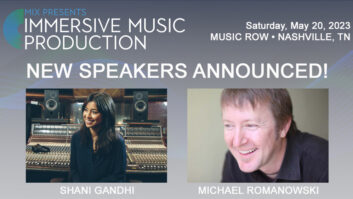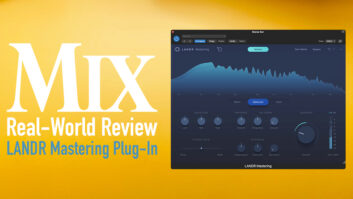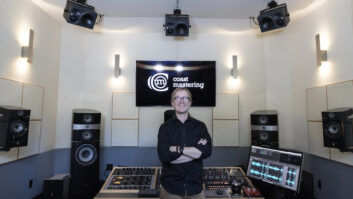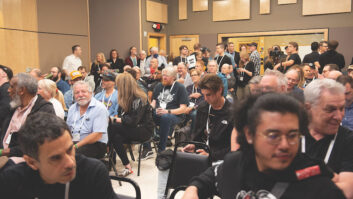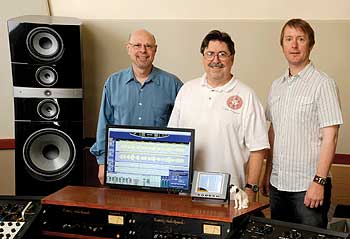
From left, the design/engineering team: Bob Hodas, Paul Stubblebine and Michael Romanowski
Photo: Rick English
There are a couple of legacies rippling through this month’s Mix cover. The first involves the owner, mastering engineer Michael Romanowski, who came to the San Francisco Bay Area from Nashville a little more than 15 years ago and has since become heir apparent in a mastering-mentor line that began with the dean of Bay Area mastering, George Horn, followed by the equally legendary Paul Stubblebine and Phil Brown.
The other legacy involves the location. When Stubblebine — a longtime first-call engineer going back to CBS Records’ The Automatt days, then Rocket Lab, then Paul Stubblebine Mastering — left his operation at Hyde Street in 2002, he assumed the lease at 1340 Mission, home of Coast Recorders. Leaving the Bill Putnam-designed space from the 1960s intact, Stubblebine and Romanowski set about building a couple of mastering rooms with the goal of creating a full-blown creative production hub.
“We built everything in these rooms ourselves,” says Romanowski, referring to the fact that he, Stubblebine and Brown actually strapped on tool belts. “We ripped everything out to the studs and implemented our own design. We knew the dimensions we wanted, the density of materials, the height; then we started building out the walls and ceiling. We built the lighting system, the bass traps, the ceiling. At various stages, we would have [acoustical consultant] Bob Hodas come in and shoot the room and we would modify accordingly.”
Berkeley-based Hodas, who has tuned more than 1,000 rooms in his career, considered this job something of a pet project. He’s been friends with Stubblebine since 1980, and it was he who introduced the team to the Focal Grande Utopia EM monitor system featured on this month’s cover. “The front rooms didn’t exist before,” explains Hodas. “I came in at the beginning of the studio renovation to consult, first on concepts and room size, and then at various stages of development for wall construction, treatments and speaker placement. We used my SIM system and Paul’s HD-1s, plus a sub to test for speaker placement and room response. This is a mastering room, so they didn’t want it to be overly absorptive.”
After diffusion was in place, bass traps built in the front corners and reverb time adjusted, six years later Hodas found himself with the team at the Rocky Mountain Audio Festival, an annual audiophile gathering. He had been familiar with the Focals and had seen the Grande Utopias in an early stage at the factory at France. In Denver, he asked Stubblebine and Romanowski, “Can you master on these?”
“I feel like this speaker was made for me,” Hodas says. “It’s a vertical array with an articulating spine, so you can line up the drivers to optimize time arrival at any listening distance. The tweeter goes out to 40k for the new HD audio, and it has an electromagnetic subwoofer that allows you to control the amount of current. With Q control, crossover and level adjustments, it’s extremely flexible and efficient.
“I was just looking for something that was brutally honest,” adds Romanowski, who uses Sonic Studio SoundBlade with Pacific Microsonics AD/DA converters and a host of analog gear, along with Pathos Adrenaline amps on the Focals. “In mastering, we need to hear what’s going on, we need it to be predicatable and we need it to be as translatable as possible. I do have digital EQ and compression — both outboard and hardware — but I have no plug-ins. I’ll use analog EQ for the broad strokes, the sculpting, and then I’ll hone in with the precision with digital. I don’t like sample rate conversion, going down or up. I guess I’m a little bit old-school.”
A little more than two years ago, Romanowski assumed the lease from Stubblebine at 1340 Mission. Today, the building houses Romanowki Mastering, along with a second, identically framed mastering room run by John Greenham; Broken Radio — the former Coast studio now run by Matt Boudreau — is a partner in the building; Mike Winger, a songwriter and producer, has production offices upstairs; and Stubblebine still masters to vinyl on the Scully lathe and devotes much of his time to The Tape Project (with partners Dan Schmalle and Romanowski), a subscriber-based series with 10 classic album releases a year on ¼-inch tape.
Vinyl? Tape? “Yes, a lot of people thought we were nuts, but we had been kicking the idea around for decades,” Stubblebine says. “We had expertise in mastering, licensing, hardware and the format. It’s a very small niche, but without overblowing the resurgence in vinyl, we discovered a market that will absorb an analog presentation. We decided to go back to master-tape presentation.
“As long as I’ve been working in San Francisco, there’s been a lot of independent activity, always a willingness on the parts of labels and individuals to take a chance,” Stubblebine adds. “You had Hi-Tone, Fantasy, Acoustic Disc and then a lot of individuals who go their own way. I’ve always related to that independent spirit within the independent community. There are a tremendous amount of tools available out there for creative people to make their own records. But the more that people do it themselves, the more they really need the final touch of professional mastering.”
